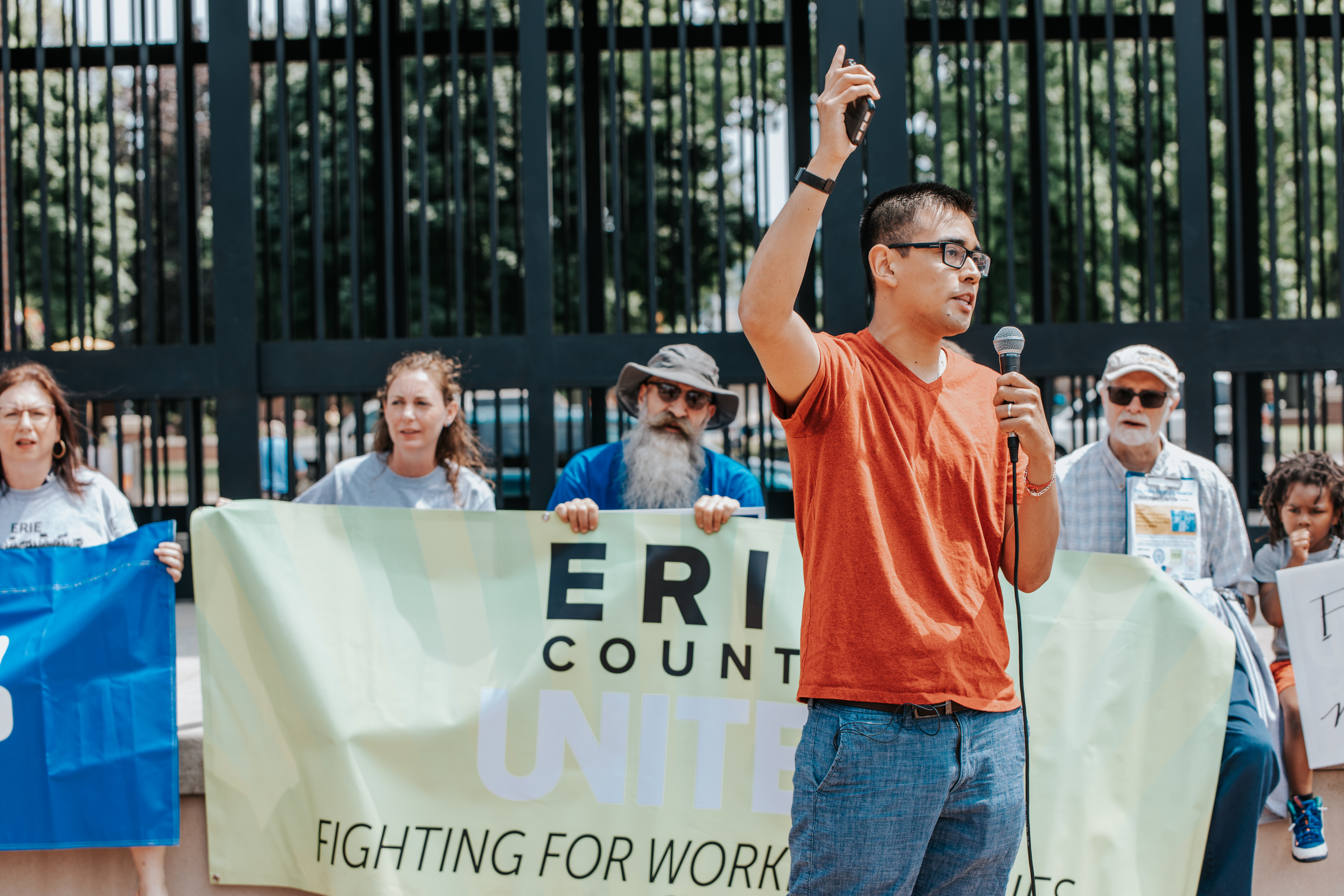Demanding More
The fight for a living wage in Erie
If you live in Erie, you're almost certainly familiar with systemic poverty. But you might be alarmed by its scope and its scale.
Last year, Business Insider (working with real estate website Trulia) reported that the 16501 area code — which includes our downtown and its immediate surroundings — has the lowest median income of any neighborhood in Pennsylvania. In regard to the city as a whole, a 2015 report from the Economic Research Institute of Erie (ERIE) lists our poverty rate at 29.2 percent — more than 15 percent higher than the state average. That rate jumps to 38.5 percent for African-Americans in our city — and to an alarming 51.7 percent for Asian-Americans. Worst of all, the report notes that 45.5 percent of children under the age of 18 were living in poverty in 2015.
When people are struggling, other hardships arise. ERIE estimates that our foreclosure rate was 5.1 percent in 2013, and that 983 of our citizens spent 2014 living on the street. They tallied 1,367 bankruptcy filings in 2017. Similarly, data from Princeton University's Eviction Lab reveals that nearly two evictions were filed per day for the entire year of 2016 in Erie County.
But not everyone is suffering. According to a 2016 report from the Economic Policy Institute (EPI), the top one percent in Pennsylvania gobbled up 42.8 percent of all economic growth between 1979 and 2007. Even in Erie, which is not exactly a haven for the ultra-rich, the total share of all income held by the top one percent in 2013 was 14.8 percent. By 2016, the EPI concluded that the top one percent in Pennsylvania makes 21.7 times more than the bottom 99 percent on average. That's more than double the rate they controlled 40 years ago.
As I type this, Pennsylvania is one of 21 states where the minimum wage is parallel to the federal minimum at $7.25 per hour. That number hasn't changed in a full decade. Earlier this summer, Governor Wolf signed a "compromise" state budget that left the issue unaddressed — despite his advocacy for an immediate raise to $12 an hour, followed by incremental adjustments building to $15 per hour by 2025.
You aren't reading a neutral assessment here. I think the governor's plan is worth implementing and that $7.25 per hour is cruel and outrageous in a country with the highest Gross Domestic Product on Earth. Fortunately, a rising number of businesses, activists, and elected officials are fighting hard for a living wage in our community. Consider this an introduction to their work and an invitation to their cause.

In light of rising costs, the local outcries for more livable wages have escalated. As of 2019, Pennsylvania is one of 21 states whose minimum wage mirrors the federal minimum wage of $7.25 an hour, a rate that has not budged in an entire decade. Photo by Maitham Basha-Agha
Making a living wage practical
In May of 2019, the nonpartisan Keystone Research Center released a report in partnership with the PA Budget and Policy Center envisioning the impact of Governor Wolf's plan. They discovered that a $12 per hour minimum would lead to an average increase in income of $3,214 per year for all full-time affected workers. That increase would impact 1.7 million people in our state, while a push to $15 an hour would impact 34 percent of our total workforce.
If the term "minimum wage" calls to mind disillusioned, pimply teenagers, think again. The report estimates that 89.4 percent of the workers affected by an increase to $15 would be over the age of 20 — and 18.6 percent would be 55 or older. They also found key benefits for groups that have been historically marginalized. For example, 60 percent of our female workforce would benefit from the increase, as would 58 percent of Hispanic workers and 47 percent of our African-American wage-earners.
But could such an increase be practical? What would the bottom line look like for a small business trying to make ends meet? To answer that question, I turned to Erie's Whole Foods Co-op (not to be confused with the national chain), where a living wage experiment is playing out locally, right before our eyes.
When LeAnna Nieratko assumed duties as general manager a few years back, the Co-op staff was already brainstorming ways to bring a living wage to its 53 employees. Nieratko, in partnership with the eight-member board of directors, decided to put these plans into action. "Any profit we're making is coming literally on the backs of our employees," says Nieratko. "If we're not paying a living wage, there's no justifiable amount of profit that would not be taken from their pockets. So I said 'Let's just do it,' and then figure out the expense situation later."
To set some clear goals, Nieratko and her co-workers turned to the Living Wage Calculator, a modeling tool created in 2004 by Massachusetts Institute of Technology (MIT) Professor Amy K. Glasmeier. The user-friendly calculator "draws upon geographically specific expenditure data related to a family's likely minimum food, childcare, health insurance, housing, transportation, and other basic necessities" to "determine the minimum employment earnings necessary to meet a family's basic needs," according to MIT's website.
In 2015, the tool determined that a single individual in Erie County would need to make $9.89 per hour to earn a living wage. Accordingly, over a five-week period during the summer of 2017, Whole Foods Co-Op bumped all affected salaries to $10 per hour, added retirement benefits, and offered paid time off for full and part-time employees. They also offered supplemental income to employees working through the Greater Erie Community Action Committee's Summer JAM program (which finds and funds jobs for young people in the community) to bring their total hourly wage to $10.
I asked Nieratko about the financial adjustments that this boost required. Surprisingly, it had no effect on the price of groceries. "I knew I couldn't touch the price because people still have to come here and shop," claims Nieratko. "And we wanted to do right by as many people as possible. We have an additional challenge because we also have a commitment to pay our producers fair wages."
Still, the adjustment was difficult. Nieratko notes that, prior to the increase, "the incoming wage in the store was $8 per hour. Now suddenly everyone was coming in at $10. If you had been here for seven years — and we have a lot of people who've been very dedicated to the Co-op for years — it probably felt a bit frustrating." Accordingly, Nieratko and her team did their best to accommodate their tenured staff. "We figured out a wage compression model that was based on other co-ops that have done living wage adjustments," she says. "If I recall correctly, it was a small bump plus an additional two cents per year of service."
"Overall, our labor percent is not obscene for a co-op," says Nieratko. "I don't feel like it impacted our bottom line that much. I feel like there are people that we have trained and put time and effort into who say 'I will stay here because I am valued here.' And so it cuts the overhead on your training."
In January of 2020, Whole Foods Co-Op will reassess wages and benefits according to the updated estimates tallied on MIT's calculator.
Mobilizing a coalition for change
An organization playing an increasingly central role in the local fight against poverty is Erie County United (ECU). According to organizer Marty Nwachukwu, their work centralizes economic justice issues, especially "educational, racial, and health access inequities." In the community, they've spent the past two years "canvassing doors, getting a feel from community members about what their issues are, advocating for people to register to vote, and turning out the vote," according to Nwachukwu. For example, they were recently instrumental in getting Michael Keys elected to City Council.
The fight for a living wage has been an important issue for the organization. "We've seen the price of goods and services go up year after year, and we've watched the cost of college go up year after year, while the wage has stayed stagnant and become less and less useful to working families," according to ECU member Elspeth Koehle. "It's not possible to rent an apartment and see to all your other needs for things like transportation and childcare for $7.25 an hour. It doesn't work."
ECU's Aaron Horton cites personal reasons for his support for a living wage. Financial trouble hit him hard during college, ultimately forcing him to drop out. "I couldn't separate my home life and my financial struggles with where I was at the time," says Horton. "As a result, I wasn't able to maintain the success I had in high school while in college." After returning to Erie, he found work for $7.50 an hour with Family Dollar. Eventually, he worked his way up to a manager position, earning $9.25. Although initially overjoyed by the salary bump, it still wasn't enough. "It's hard to find solid ground when you're trying to get ahead and contribute to your community when an unlivable wage puts you at a huge disadvantage," says Horton. "You have to work that much harder just to meet the bare minimum."
Concerns about economic justice led Erie County United to advocate for changes to our city's Local Economic Revitalization Tax Assistance (LERTA) program. LERTA is a program designed to encourage building construction and renovations in Erie, as well as greater economic investment, by offering (among other things) 100 percent tax abatement on city and county taxes for commercial and residential upgrades over a 10-year period. "We're obviously not against development or homeowners improving their properties," says Koehle. "But we want to ensure that we hold developers accountable so that they provide for living wages in those jobs."
Accordingly, ECU produced an ordinance to enhance the job and wage requirements included in earlier versions of LERTA, demanding affordable housing requirements for new development, insisting that 15 percent of new employment related to development go to local people, and advocating for wages at 125 percent of PA's minimum wage. Although their proposal gained support from County Councilman Andre Horton, City Council members Kathy Schaaf and Liz Allen, and school board members Angela McNair and Tyler Titus, LERTA passed in early July without their adjustments.
Finally, Erie County United played a key role in organizing the second annual Poor People's March in July of this year. Inspired by the marches of Martin Luther King Jr. in the 1960s — as well as Reverend William Barber's "national call for a moral revival" in the present — the march brought together over 100 local citizens concerned about poverty and inequity in our region. And a surprisingly diverse group of local organizations — ranging from the NAACP to the Sierra Club — helped make it happen.
On an unusually pleasant Monday afternoon in Perry Square, speakers at the march addressed economic and social justice issues from a variety of perspectives. Michael Bagdes-Canning noted the importance of access to clean drinking water. Luis Rodriguez addressed the conditions that asylum seekers are being held in at facilities in Erie County. Kennedy Horton demanded "a brick-and-mortar community college for our region," noting that area universities haven't done enough to provide affordable access to education. Becky Pruveadenti of Healthcare 4 All Pennsylvania addressed the need for "affordable, accessible healthcare."

Activists like Luis Rodriguez spoke at the second annual Poor People's March organized by Erie County United organized in July to raise awareness of economic injustice. A matter of particular concern is the Local Economic Revitalization Tax Assistance (LERTA) program, which excuses developers from paying city and county taxes on new or upgraded commercial and residential properties for a 10-year period. Photo by Maitham Basha-Agha
As the event drew to a close, Erie NAACP President Gary Horton led the crowd in a simple, but effective chant: "More for the poor!" It's a simple sentiment, and though it doesn't necessarily speak to the complexities of local government or late-capitalist economics, it makes a strong appeal to one's sense of right and wrong.
A living wage — and yes, even a $15 minimum wage — makes a similar appeal. Fifteen dollars an hour won't necessarily prevent companies from laying off unskilled workers. It probably won't do much to address discriminatory hiring practices either. But maybe it's a starting point rather than an end goal.
A community that pays its members a living wage is more likely to be a community that looks out for small businesses forced to make adjustments. A community that believes that work should have dignity is more likely to look at discrimination, incarceration, and access to affordable housing with concern rather than contempt. A community that pays people well will encourage good people to invest in it. Let's be that kind of community.
Dan Schank can be reached at dschank@eriereader.com




